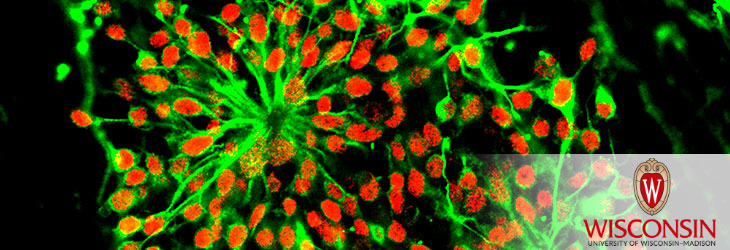Pluripotent Stem Cells

Method and System for Delivering Nucleic Acid into a Target Cell
WARF: P06064US
Inventors: William Murphy, Siyoung Choi
The Wisconsin Alumni Research Foundation (WARF) is seeking commercial partners interested in developing a DNA delivery method that enables spatial and temporal control over the transfection of stem cells.
Overview
The normal growth and development of tissue requires a complex interplay of multiple signals from multiple genes in well-defined locations, leading to the controlled differentiation of precursor cells into mature, tissue-specific cell types. Ultimately, control over gene expression in a three-dimensional construct could allow the growth of transplantable hybrid tissues or organs from a single stem cell precursor. However, previous approaches for delivering DNA sequences, such as plasmid DNA and antisense oligonucleotides, to direct cell activity have been unable to spatially control the transfer of multiple DNA sequences to cells within 3-dimensional matrices.
The Invention
UW-Madison researchers have developed a DNA delivery method that uses a sequestering approach to enable spatial and temporal control over the transfection of stem cells. Oligonucleotide “handles” are covalently attached to a supporting substrate, which may be a solid surface or a two- or three-dimensional semi-solid structure, such as a hydrogel network. The oligonucleotides sequester complementary nucleic acid molecules, such as DNA, in pre-determined locations. The length of the oligonucleotides handles can be varied to control the availability of the sequestered DNA. Recipient cells are adhered to the substrate, and the nucleic acid molecules are exposed to the cells under conditions that support transfection. The culture conditions can be controlled to modulate the timing with which the DNA is made available to the cells.
Applications
- Tissue engineering
- Controlled gene expression
Key Benefits
- Enables tightly controlled transfection of cells, including human mesenchymal stem cells
- Increases transfection efficiency
- Can be used to transfer any gene that can be included in a plasmid vector
- Can be used to transfer antisense oligonucleotide sequences to “knock down” gene expression
- Nucleic acid molecules can be repeatedly transferred into cells to spatially and/or temporally direct multi-step differentiation of the cells.
- Because the oligonucleotides are small and chemically stable, they can be covalently attached to materials without substantially affecting the material properties.
- May enhance our ability to engineer tissues, particular functional cardiovascular tissues
Additional Information
For More Information About the Inventors
Tech Fields
For current licensing status, please contact Rafael Diaz at [javascript protected email address] or 608-960-9847